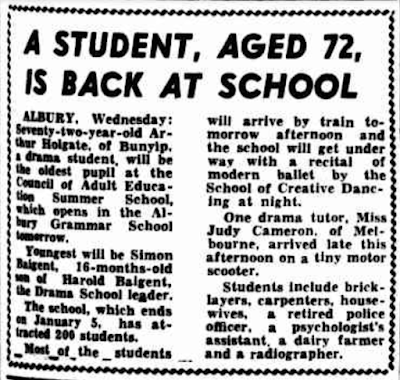The Society had maybe 15 to 20 members who also made the stage sets; Dad built the train for the play which was set on the train.
His acting career started largely because he had the essential attributes of being young, male, tall and willing. Another member of the Society was Win Reid who taught Dad at Sunday School at Cora Lynn and she organised the Sunday school concerts and also taught elocution and encouraged Dad to join the Repertory Society. It was a short lived acting career which was fun while it lasted and he still remembers the advice he was given which was ‘to speak to the back row, so your voice carries’
Other members of the Society were Hughie Pound who ran the Radio store in Bunyip, where Loretta’s Hairdressing is now located; Colin Flett who had a general store, with a good range of hardware, where the Bendigo Bank is; Frank Harker who lived on Eleven Mile road at Cora Lynn (all that remains of his house are the two palm trees in the paddock); Don and Pat Whysall – Don was in the Fire Brigade and Pat was a teacher; Betty Storey, who lived on Murray Road, a neighbour of the Rouses; Dad’s oldest sister Nancy; Nelly Dixon (nee Edis) married to Geoff Dixon, who was a builder; Russell and Elizabeth Spence - remembered as ‘an older couple’ and Arthur Holgate, who was ‘quite old’. Mr Holgate was the local Registrar of Births and Deaths and is remembered in our family because he incorrectly registered the date of my sister Megan’s birth in 1957. He wrote the registration date down as the birth date and we didn’t find out until she had to apply for a birth certificate 20 or so years later.
Denise Nest has a paragraph about the Dramatic Society in her book, The Call of the Bunyip: history of Bunyip, Iona and Tonimbuk 1847 to 1900. She mentions a few other names apart from the ones Dad remembers - Rex Taylor and members of the Thomas and Roberts families.
The Bunyip Dramatic Society is believed to have been established under the auspices of the Council of Adult Education (CAE) which was formed in 1947 to encourage, inter alia, community activities including the performing arts*. The CAE also held drama summer schools and I came across this report, from The Argus, December 27, 1956 of Arthur Holgate attending that year. He was 72 at the time, so it is no wonder that Dad, who was 50 years younger, remembered him as being 'quite old'. The article is also interesting as it lists the range of occupations of people involved in amateur theatre at the time.
Report of Arthur Holgate attending a CAE Drama Summer school.
The Argus December 27, 1956 https://trove.nla.gov.au/newspaper/article/71773285
* Victorian Drama League website https://vdl.org.au/from-convicts-to-covid-19-amateur-theatre-in-victoria/

